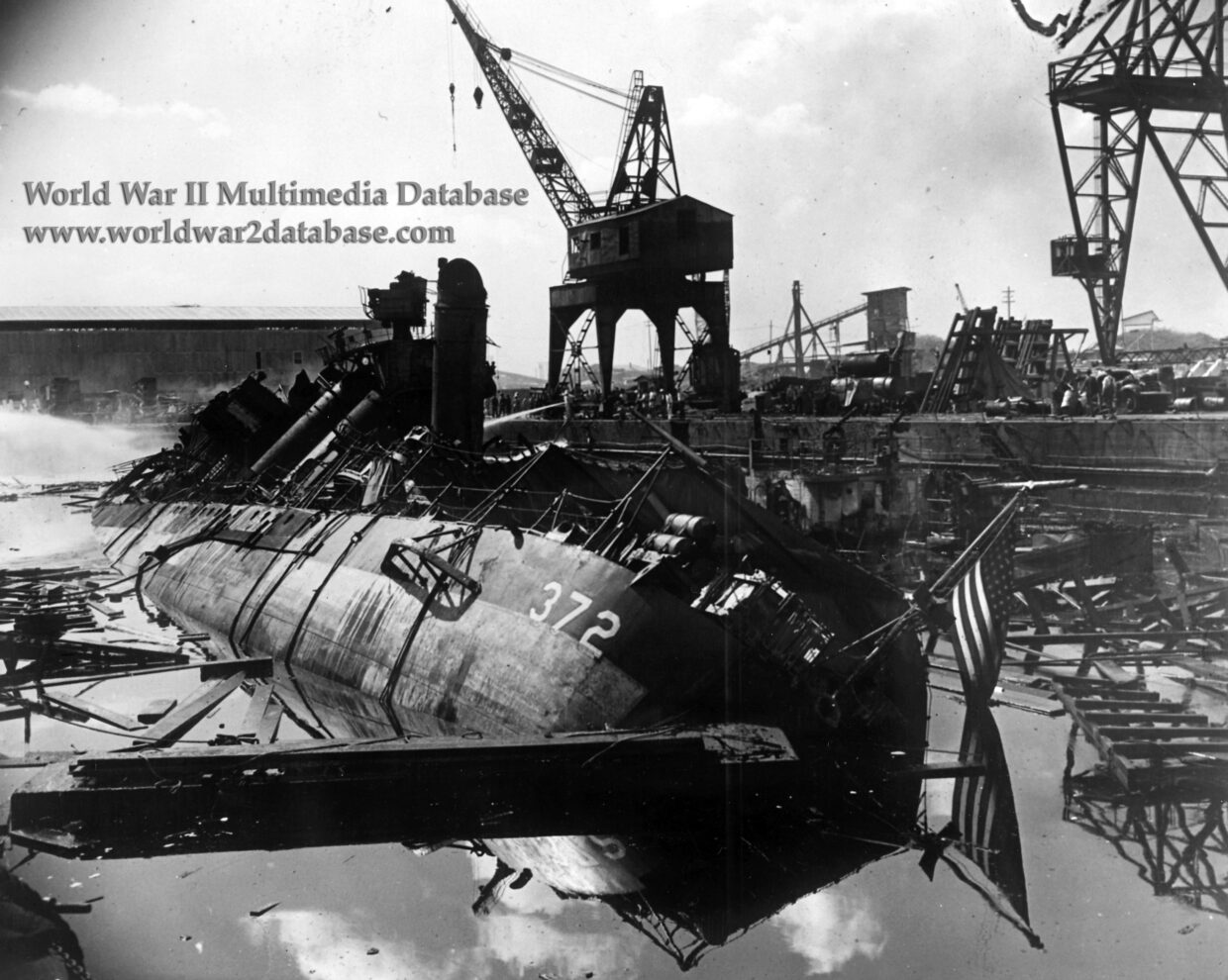| USS Cassin (DD-372) burned out and capsized against USS Downes (DD-375), in the Pearl Harbor Navy Yard drydock on 7 December 1941, after the Japanese attack.The bombs which struck or exploded near Cassin and USS Downes (DD-375) were the 250 kilogram type and were dropped by both high-level and dive-bombers. Incendiary bombs were not dropped as was reported originally by ship crews. High-level planes were active in the area at about 0815 Hours, but it was not until 0850 that ten or fifteen dive-bombers approached. About ten of these attacked Nevada while the remainder covered the ships in Drydock Number One and in the floating drydock. At this time a hit was scored on Cassin. It went out through the bottom of the ship at frame 140 and struck the drydock floor between Cassin and Downes, starting a fire immediately. A few minutes later a bomb struck the edge of the dock on the starboard side, and another on the port side. These hits cut off the water supply of the Yard and also the electric power. A second bomb struck Cassin and passed through the ship in the vicinity of frame 60. The fragments from this bomb penetrated both ships and their fuel oil tanks. By this time the oil fires extended the full length of both ships, and both were being abandoned when the second bomb landed. The third bomb hit Downes and demolished the director platform, the bridge, and the charthouse. The fuel oil fires eventually reached the depth charges and the torpedoes. Without adequate water the fires raged on both ships and in the drydock. The Yard desired to flood the drydock as early as 0815 but no action was taken for an hour. At that time Cassin came afloat astern and pivoted on her forefoot. This, together with the free surface, caused Cassin to become unstable. She fell over on Downes. The fuel oil fires caused havoc before the water level was high enough to protect the hulls of the two ships. The fragments from the first bomb penetrated the oil tanks of both vessels and loose oil fed the fires which were started. The thick black smoke, which is characteristic of burning fuel oil, prevented the crews from fighting the fires which engulfed both ships. Explosions on Downes were the cause of much of the damage. The bomb hits were not in themselves of real account. The explosions were caused by fuel oil tanks becoming overheated, by 5-inch ammunition in ready boxes, by the powder in the forward magazine, and either by torpedo air flasks or torpedo warheads. Regardless of which part of the torpedoes was the real culprit, one of the assemblies was found in the yard seventy-five feet from its starting point. The force of the explosions was sufficient to wreck everything in its path. The most severe damage on Downes was caused by a torpedo explosion near the after stack. Here a large hole in the deck and side resulted. The damage to the hulls of the two destroyers from oil fires, the toppling of Cassin, and explosions, etc. was extensive. Both vessels were pocked with holes. As for Cassin, the flat keel was warped and was about 18 inches above the baseline, the hull was hogged (raised in the middle) from 10 to 17 inches, the bow was about two feet high, and both struts were out of position. The shell plating of Cassin was badly wrinkled especially on the starboard side. Downes was in worse shape as regards longitudinal strength. The bow was nearly 40 inches high, the stern 40 inches low, and the hull twisted and hogged. The plating was badly wrinkled from fire and strain, and damaged by many fragments. Both vessels, on later examination, showed that their main propulsive machinery was in relatively good shape, as were the hull fittings and machinery throughout. However, the aluminum plating of Downes‘ deckhouse was completely destroyed and the corrosion-resisting steel panels of the deckhouses of both ships were badly wrinkled. There was wide diversity of opinion as to the proper disposition of these ships. The Salvage Officer felt that in view of the dire scarcity of ships Cassin and Downes could be used for limited escort or patrol duties. Some felt that the machinery and suitable hull fittings should be preserved and installed in new hulls. Eventually the forces afloat agreed with the opinion of the Navy Yard that the hulls be scrapped and the machinery and usable fittings and parts of the vessels be sent to Mare Island. To this the Bureau of Ships and the Navy Department agreed. It was ordered that both ships be scrapped after removing from them all the machinery and parts that would be helpful to Mare Island. It was important that these be properly labelled before the parts were sent in various ships to the building yard. The scrapping of Downes was completed in drydock in August 1942 and of Cassin in October 1942. Mare Island Navy Yard completed the ships in November 1943 and February 1944 respectively. | |
| Image Filename | wwii1399.jpg |
| Image Size | 1.13 MB |
| Image Dimensions | 2924 x 2335 |
| Photographer | Unknown |
| Photographer Title | United States Navy |
| Caption Author | ice Admiral Homer N. Wallin, United States Navy |
| Date Photographed | December 07, 1941 |
| Location | Navy Yard |
| City | Pearl Harbor |
| State or Province | Hawaii |
| Country | United States of America |
| Archive | National Archives and Records Administration |
| Record Number | 80-G-32431 |
| Status | Caption ©2010, ©2024 MFA Productions LLC Image in the Public Domain |

Author of the World War II Multimedia Database

